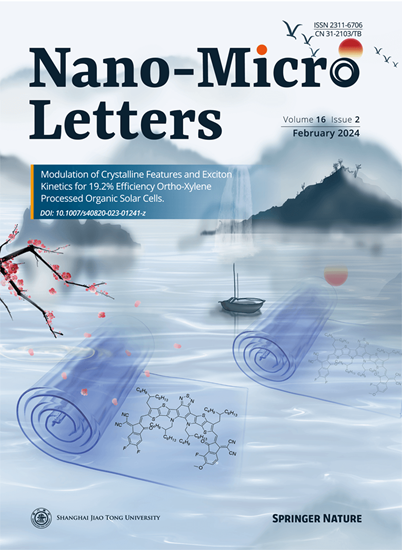工程异质结构三位一体实现了低介电损耗的防火、导热聚合物纳米复合薄膜
IF 26.6
1区 材料科学
Q1 Engineering
引用次数: 0
摘要
本文章由计算机程序翻译,如有差异,请以英文原文为准。
An Engineered Heterostructured Trinity Enables Fire-Safe, Thermally Conductive Polymer Nanocomposite Films with Low Dielectric Loss
Highlights
-
The as-fabricated waterborne polyurethane (WPU) nanocomposite film exhibits a 55.6% improvement in limiting oxygen index, 66.0% and 40.5% reductions in peak heat release rate and total heat release, respectively, and 93.3% increase in tensile strength relative to pure WPU film.
-
The resultant WPU nanocomposite film presents a high thermal conductivity (λ) of 12.7 W m−1 K−1 and a low dielectric constant (ε) of 2.92 at 106 Hz.
求助全文
通过发布文献求助,成功后即可免费获取论文全文。
去求助
来源期刊

Nano-Micro Letters
NANOSCIENCE & NANOTECHNOLOGY-MATERIALS SCIENCE, MULTIDISCIPLINARY
CiteScore
32.60
自引率
4.90%
发文量
981
审稿时长
1.1 months
期刊介绍:
Nano-Micro Letters is a peer-reviewed, international, interdisciplinary, and open-access journal published under the SpringerOpen brand.
Nano-Micro Letters focuses on the science, experiments, engineering, technologies, and applications of nano- or microscale structures and systems in various fields such as physics, chemistry, biology, material science, and pharmacy.It also explores the expanding interfaces between these fields.
Nano-Micro Letters particularly emphasizes the bottom-up approach in the length scale from nano to micro. This approach is crucial for achieving industrial applications in nanotechnology, as it involves the assembly, modification, and control of nanostructures on a microscale.
 求助内容:
求助内容: 应助结果提醒方式:
应助结果提醒方式:


